Coat Texturing
Many patterns, such as dappling, appaloosa spotting, paint/pinto spotting, brindle striping, and dun factor markings, are also accompanied by various forms of coat texturing.
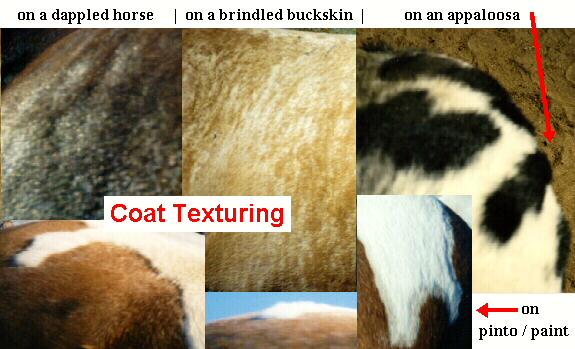
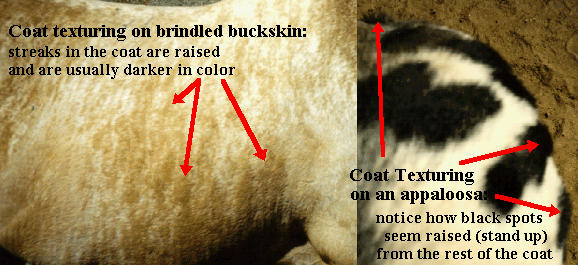
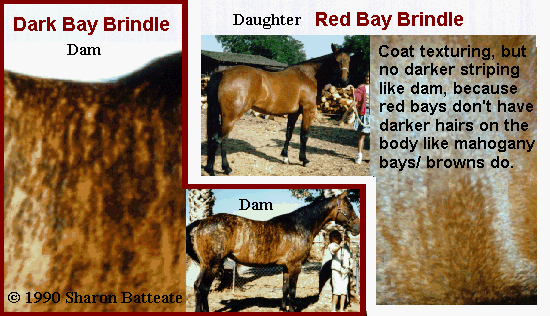
Many patterns, such as dappling, appaloosa spotting, paint/pinto spotting, brindle striping, and dun factor markings, are also accompanied by various forms of coat texturing.



Brindles often exhibit a "motheaten" type of coat texturing consisting of longer and shorter hairs. In some lines of brindles, the foals are born with the coat texturing and brindle striping, and the striping is also visible throughout the year (the Brenda Batty Atty line.
However, in another line of brindle (the Im A Star Moon Bar line), while the coat-texturing is usually visible throughout the year, the darker (or sometimes lighter) drippy-looking brindle striping is not. Foals are not always born with the pattern - it tends to develop later after they shed their foal coats. The first sign is usually the coat texturing, and then seasonally the brindle striping will appear. Hence, I often refer to this type of brindle as "seasonal" brindle.


The mare Im A Star Moon Bar (above) has the swirl over the hip and drippy striping that is characteristic of brindle, but she also had dappling as well. Dappling and brindling both involve areas of shorter and longer hair, but dappling should not be confused with brindling. You might want to see the article on Dapple if you are uncertain of the difference.
Brindle is an irregular drippy looking striping or vertical streaking (even on the legs), whereas dappling is generally circular spots, and dun factor markings tend to be regularly spaced. Any of the above coat patterns, as well as "sooty/smutty" striping discussed below, will exhibit coat texturing.
Brindling is not the same as the regularly spaced striping seen on some "sooty/smutty" striped horses, and on dun-factor horses. Dun factor horses have horizontal striping on their legs, whereas brindles have vertical striping on their legs. In some cases, a horse might carry both dun factor and brindle, such as the horse pictured below. In these cases I look for striping in the flank (such as seen on the left). Flank striping and a swirl over the hip are common in brindles, but are not usually common in "sooty/smutty" striped horses or in dun factor striped horses.

Below are some pictures Janelle Johnson took of her foals exhibiting the "motheaten" coat texturing seen on brindle foals from the Im A Star Moon Bar line of brindle.
Janelle (Osborne) Johnson: (417) 741-7924, email: Janelle Johnson, website: Just A Splash of Paint Ranch.
If you are interested in acquiring a horse from one of the inheritable types of brindle lines, visit her website via the link above. She has a number of brindle offspring for sale. Janelle has also been able to get some good pictures of the brindle coat texturing seen on brindle foals.
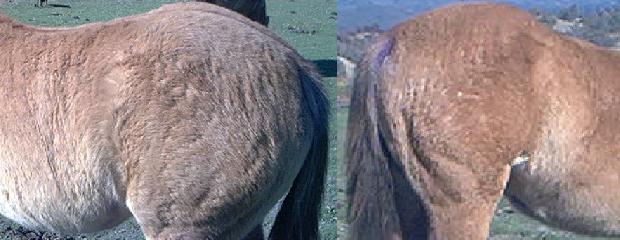
Foals from this line of brindle often go through a "curly" stage (not seen in the other line) in their weanling and sometimes also in their yearling year. However, after 2 yrs of age, they generally do not exhibit a curly coat, although some may retain some wavy hair on the lower legs. Below are some pictures Janelle took of a weanling in the "curly" stage, and then after the foal shed out the following year.
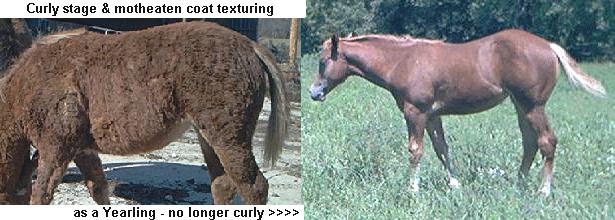
Both this line, as well as the other line of brindle, usually exhibit a sparser mane and tail. It looks like a mane/tail that has been pulled or thinned out for showing purposes (which I like because it is much less work for me). However, the range of thickness of the mane/tail is influenced by other factors. Foals that also carry dun factor tend to have a heavier mane/tail, and on the other extreme, I have even seen one of the foals revert to a shorter upright mane seen on primitive equines (przewalski's horse, zebras, and wild asses).
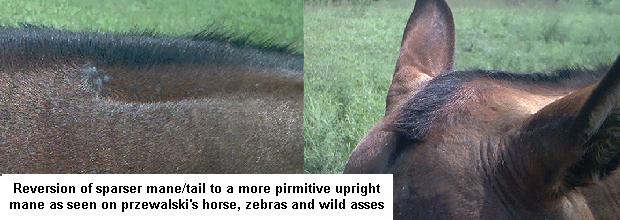
Unless otherwise noted, the articles on this site are by J. Sharon Batteate [email protected] The pictures and information on this site are for informational purposes, in order to educate people on the Brindle pattern. The pictures and information on this site are copyrighted. All rights reserved. No part may be reproduced, stored in a retrieval system, or transmitted in any form or by any means, electronic, mechanical, photocopying, recording, or otherwise, without the prior permission of the copyright holders.
You may also contact me: (209) 477-1536, J. Sharon Batteate, PO Box 8535, Stockton, CA 95208 USA